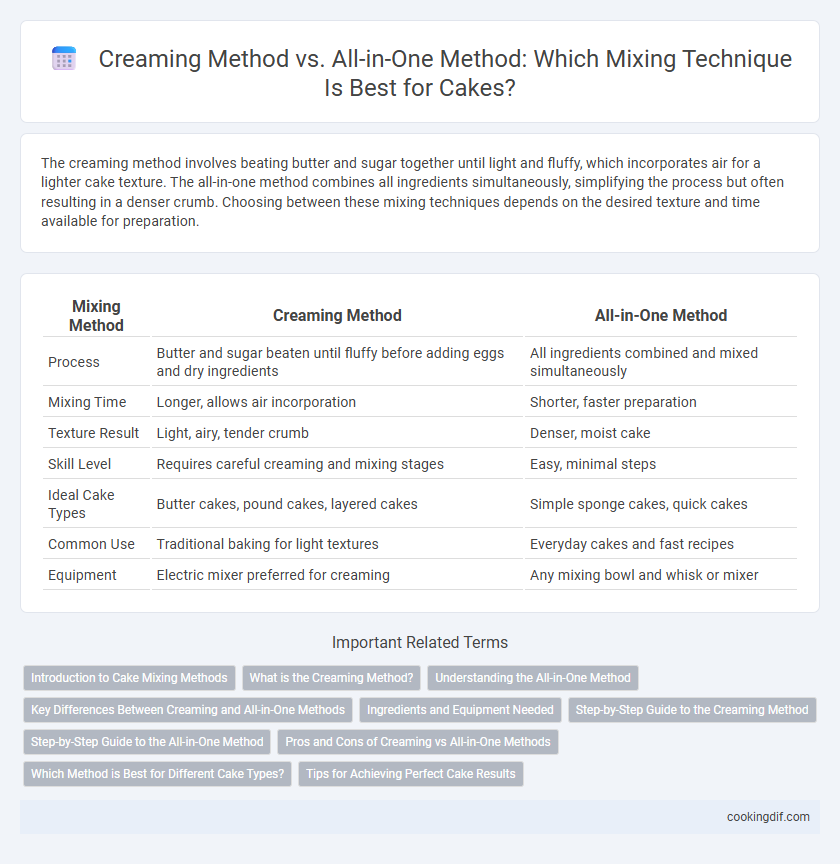The creaming method involves beating butter and sugar together until light and fluffy, which incorporates air for a lighter cake texture. The all-in-one method combines all ingredients simultaneously, simplifying the process but often resulting in a denser crumb. Choosing between these mixing techniques depends on the desired texture and time available for preparation.
Table of Comparison
| Mixing Method | Creaming Method | All-in-One Method |
|---|---|---|
| Process | Butter and sugar beaten until fluffy before adding eggs and dry ingredients | All ingredients combined and mixed simultaneously |
| Mixing Time | Longer, allows air incorporation | Shorter, faster preparation |
| Texture Result | Light, airy, tender crumb | Denser, moist cake |
| Skill Level | Requires careful creaming and mixing stages | Easy, minimal steps |
| Ideal Cake Types | Butter cakes, pound cakes, layered cakes | Simple sponge cakes, quick cakes |
| Common Use | Traditional baking for light textures | Everyday cakes and fast recipes |
| Equipment | Electric mixer preferred for creaming | Any mixing bowl and whisk or mixer |
Introduction to Cake Mixing Methods
The creaming method involves beating butter and sugar together until light and fluffy, creating a fine crumb and airy texture in cakes. The all-in-one method combines all ingredients simultaneously, simplifying preparation and reducing mixing time while still producing moist cakes. Both methods influence the cake's structure, texture, and overall flavor profile by affecting air incorporation and ingredient distribution.
What is the Creaming Method?
The creaming method is a cake-mixing technique where butter and sugar are beaten together until light and fluffy, creating a stable base that traps air for a tender crumb. This process enhances the cake's texture by incorporating more air compared to the all-in-one method, which combines all ingredients at once. Bakers often choose the creaming method for cakes like butter cakes and pound cakes to achieve a finer, more delicate crumb structure.
Understanding the All-in-One Method
The All-in-One method simplifies cake preparation by blending all ingredients simultaneously, ensuring uniform batter consistency and reducing mixing time. This technique is ideal for moist, tender cakes, as it promotes even incorporation of fats, sugars, and eggs, preventing overmixing and gluten development. Compared to the Creaming method, which requires separately beating butter and sugar for aeration, the All-in-One approach delivers consistent texture with minimal effort.
Key Differences Between Creaming and All-in-One Methods
The creaming method involves beating butter and sugar together to incorporate air, resulting in a light and fluffy cake texture, while the all-in-one method combines all ingredients simultaneously, saving time but often producing a denser crumb. Temperature control is crucial in the creaming technique to achieve proper aeration, whereas the all-in-one method is more forgiving with ingredient temperatures due to its simplified process. Understanding these key differences helps bakers choose the appropriate mixing technique to influence cake texture, rise, and overall quality.
Ingredients and Equipment Needed
The creaming method requires butter or shortening and granulated sugar beaten together until light and fluffy, usually needing a stand mixer with a paddle attachment for optimal aeration. The all-in-one method combines all ingredients--including flour, sugar, fat, eggs, and liquid--simultaneously in one bowl, making a hand mixer or electric whisk the essential equipment to ensure even blending. Ingredient ratios differ, with the creaming method emphasizing creamed fats and sugar for texture, while the all-in-one method relies on thorough mixing to achieve uniform batter consistency.
Step-by-Step Guide to the Creaming Method
The creaming method involves beating butter and sugar together until light and fluffy, which incorporates air for a tender cake crumb. Next, eggs are added one at a time, ensuring each is fully integrated before mixing in sifted dry ingredients alternated with liquids for even consistency. This step-by-step approach produces a well-aerated batter that yields a moist, delicate cake texture distinct from the denser results of the all-in-one method.
Step-by-Step Guide to the All-in-One Method
The all-in-one method simplifies cake mixing by combining all ingredients--flour, sugar, eggs, fat, and liquid--into a single bowl, reducing preparation time and minimizing cleanup. Start by adding the dry ingredients, followed by eggs and liquid components, then mix until achieving a smooth, uniform batter without overbeating to maintain cake tenderness. This streamlined approach enhances efficiency while producing consistent texture and rise, especially suited for denser cakes like pound cakes and butter cakes.
Pros and Cons of Creaming vs All-in-One Methods
The creaming method provides a lighter, airier cake texture by thoroughly beating butter and sugar to incorporate air, which promotes better volume and crumb structure, but it requires more time and effort. The all-in-one method simplifies baking by combining all ingredients at once, saving time and reducing equipment needed, yet it may result in denser cakes due to less air incorporation. Choosing between the two depends on the desired cake texture and available preparation time, with creaming suitable for sponge cakes and all-in-one better for quick cakes or those with minimal rise.
Which Method is Best for Different Cake Types?
The creaming method, which involves beating butter and sugar to incorporate air, is ideal for butter cakes and pound cakes, creating a light and tender crumb. The all-in-one method, where all ingredients are mixed simultaneously, suits sponge cakes and simple everyday cakes, providing a quicker and more efficient process without compromising texture. Selecting the right method depends on the cake type and desired texture, with creaming favored for richness and volume, and all-in-one for convenience and moistness.
Tips for Achieving Perfect Cake Results
The creaming method, involving beating butter and sugar until light and fluffy, creates a tender crumb by incorporating air, essential for cakes like pound or butter cakes. The all-in-one method simplifies preparation by combining all ingredients at once, ideal for quick sponge cakes but requires precise ingredient temperature to avoid dense texture. For perfect results, ensure butter is softened for creaming and sift dry ingredients in the all-in-one method to maintain the cake's lightness and rise.
Creaming method vs All-in-one method for mixing Infographic

 cookingdif.com
cookingdif.com